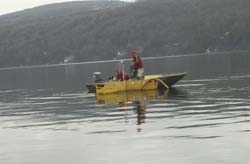6 A&S Physicists Awarded Breakthrough Prize
Our universe is dominated by matter and contains hardly any antimatter, a notion which still perplexes top scientists researching at CERN’s Large Hadron Collider. The Big Bang created equal amounts of matter and antimatter, but now nearly everything—solid, liquid, gas or plasma—is…


 This research has shown the importance of utilizing innovative technology to manage and monitor complex aquatic ecosystems in urban settings. Oftentimes, programs for treating water systems are implemented without robust data to identify the true source of the problem. The value of this case study comes from the large number of cause-and-effect relationships that were clearly identified through the monitoring system.
This research has shown the importance of utilizing innovative technology to manage and monitor complex aquatic ecosystems in urban settings. Oftentimes, programs for treating water systems are implemented without robust data to identify the true source of the problem. The value of this case study comes from the large number of cause-and-effect relationships that were clearly identified through the monitoring system.